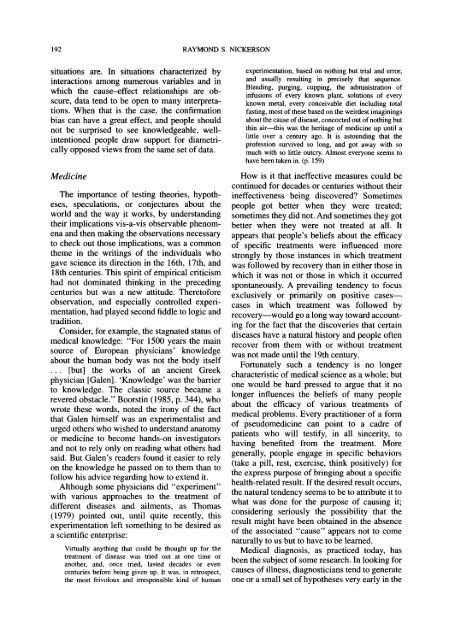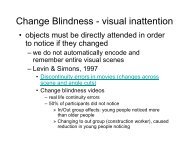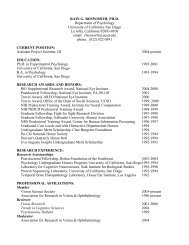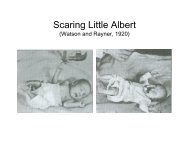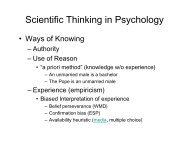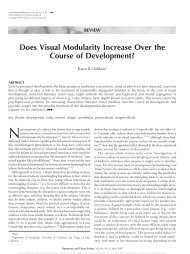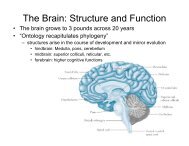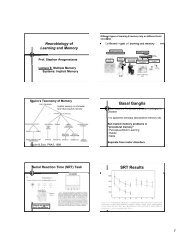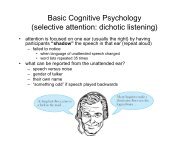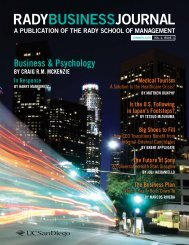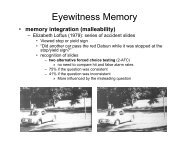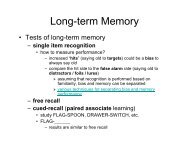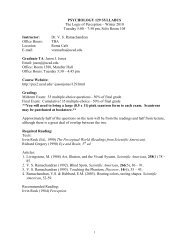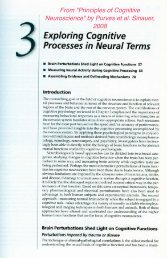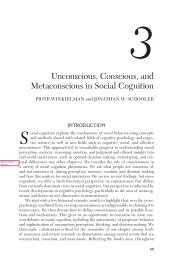Confirmation Bias: A Ubiquitous Phenomenon in Many Guises
Confirmation Bias: A Ubiquitous Phenomenon in Many Guises
Confirmation Bias: A Ubiquitous Phenomenon in Many Guises
You also want an ePaper? Increase the reach of your titles
YUMPU automatically turns print PDFs into web optimized ePapers that Google loves.
192 RAYMOND S. NICKERSON<br />
situations are. In situations characterized by<br />
<strong>in</strong>teractions among numerous variables and <strong>in</strong><br />
which the cause-effect relationships are obscure,<br />
data tend to be open to many <strong>in</strong>terpretations.<br />
When that is the case, the confirmation<br />
bias can have a great effect, and people should<br />
not be surprised to see knowledgeable, well<strong>in</strong>tentioned<br />
people draw support for diametrically<br />
opposed views from the same set of data.<br />
Medic<strong>in</strong>e<br />
The importance of test<strong>in</strong>g theories, hypotheses,<br />
speculations, or conjectures about the<br />
world and the way it works, by understand<strong>in</strong>g<br />
their implications vis-a-vis observable phenomena<br />
and then mak<strong>in</strong>g the observations necessary<br />
to check out those implications, was a common<br />
theme <strong>in</strong> the writ<strong>in</strong>gs of the <strong>in</strong>dividuals who<br />
gave science its direction <strong>in</strong> the 16th, 17th, and<br />
18th centuries. This spirit of empirical criticism<br />
had not dom<strong>in</strong>ated th<strong>in</strong>k<strong>in</strong>g <strong>in</strong> the preced<strong>in</strong>g<br />
centuries but was a new attitude. Theretofore<br />
observation, and especially controlled experimentation,<br />
had played second fiddle to logic and<br />
tradition.<br />
Consider, for example, the stagnated status of<br />
medical knowledge: "For 1500 years the ma<strong>in</strong><br />
source of European physicians' knowledge<br />
about the human body was not the body itself<br />
... [but] the works of an ancient Greek<br />
physician [Galen]. 'Knowledge' was the barrier<br />
to knowledge. The classic source became a<br />
revered obstacle." Boorst<strong>in</strong> (1985, p. 344), who<br />
wrote these words, noted the irony of the fact<br />
that Galen himself was an experimentalist and<br />
urged others who wished to understand anatomy<br />
or medic<strong>in</strong>e to become hands-on <strong>in</strong>vestigators<br />
and not to rely only on read<strong>in</strong>g what others had<br />
said. But Galen's readers found it easier to rely<br />
on the knowledge he passed on to them than to<br />
follow his advice regard<strong>in</strong>g how to extend it.<br />
Although some physicians did "experiment"<br />
with various approaches to the treatment of<br />
different diseases and ailments, as Thomas<br />
(1979) po<strong>in</strong>ted out, until quite recently, this<br />
experimentation left someth<strong>in</strong>g to be desired as<br />
a scientific enterprise:<br />
Virtually anyth<strong>in</strong>g that could be thought up for the<br />
treatment of disease was tried out at one time or<br />
another, and, once tried, lasted decades or even<br />
centuries before be<strong>in</strong>g given up. It was, <strong>in</strong> retrospect,<br />
the most frivolous and irresponsible k<strong>in</strong>d of human<br />
experimentation, based on noth<strong>in</strong>g but trial and error,<br />
and usually result<strong>in</strong>g <strong>in</strong> precisely that sequence.<br />
Bleed<strong>in</strong>g, purg<strong>in</strong>g, cupp<strong>in</strong>g, the adm<strong>in</strong>istration of<br />
<strong>in</strong>fusions of every known plant, solutions of every<br />
known metal, every conceivable diet <strong>in</strong>clud<strong>in</strong>g total<br />
fast<strong>in</strong>g, most of these based on the weirdest imag<strong>in</strong><strong>in</strong>gs<br />
about the cause of disease, concocted out of noth<strong>in</strong>g but<br />
th<strong>in</strong> air—this was the heritage of medic<strong>in</strong>e up until a<br />
little over a century ago. It is astound<strong>in</strong>g that the<br />
profession survived so long, and got away with so<br />
much with so little outcry. Almost everyone seems to<br />
have been taken <strong>in</strong>. (p. 159)<br />
How is it that <strong>in</strong>effective measures could be<br />
cont<strong>in</strong>ued for decades or centuries without their<br />
<strong>in</strong>effectiveness be<strong>in</strong>g discovered? Sometimes<br />
people got better when they were treated;<br />
sometimes they did not. And sometimes they got<br />
better when they were not treated at all. It<br />
appears that people's beliefs about the efficacy<br />
of specific treatments were <strong>in</strong>fluenced more<br />
strongly by those <strong>in</strong>stances <strong>in</strong> which treatment<br />
was followed by recovery than <strong>in</strong> either those <strong>in</strong><br />
which it was not or those <strong>in</strong> which it occurred<br />
spontaneously. A prevail<strong>in</strong>g tendency to focus<br />
exclusively or primarily on positive cases—<br />
cases <strong>in</strong> which treatment was followed by<br />
recovery—would go a long way toward account<strong>in</strong>g<br />
for the fact that the discoveries that certa<strong>in</strong><br />
diseases have a natural history and people often<br />
recover from them with or without treatment<br />
was not made until the 19th century.<br />
Fortunately such a tendency is no longer<br />
characteristic of medical science as a whole; but<br />
one would be hard pressed to argue that it no<br />
longer <strong>in</strong>fluences the beliefs of many people<br />
about the efficacy of various treatments of<br />
medical problems. Every practitioner of a form<br />
of pseudomedic<strong>in</strong>e can po<strong>in</strong>t to a cadre of<br />
patients who will testify, <strong>in</strong> all s<strong>in</strong>cerity, to<br />
hav<strong>in</strong>g benefited from the treatment. More<br />
generally, people engage <strong>in</strong> specific behaviors<br />
(take a pill, rest, exercise, th<strong>in</strong>k positively) for<br />
the express purpose of br<strong>in</strong>g<strong>in</strong>g about a specific<br />
health-related result. If the desired result occurs,<br />
the natural tendency seems to be to attribute it to<br />
what was done for the purpose of caus<strong>in</strong>g it;<br />
consider<strong>in</strong>g seriously the possibility that the<br />
result might have been obta<strong>in</strong>ed <strong>in</strong> the absence<br />
of the associated "cause" appears not to come<br />
naturally to us but to have to be learned.<br />
Medical diagnosis, as practiced today, has<br />
been the subject of some research. In look<strong>in</strong>g for<br />
causes of illness, diagnosticians tend to generate<br />
one or a small set of hypotheses very early <strong>in</strong> the


